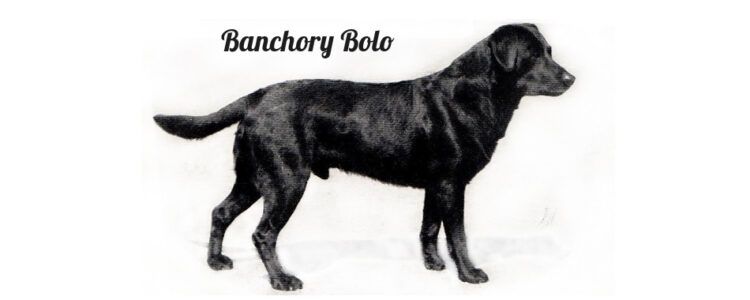
Banchory Bolo was the first-ever Dual Champion Labrador Retriever.
His is an interesting story. Not just rags to riches, but riches to rags and back to riches. Pull up a chair and learn about the dog who still has an influence on Labradors over one hundred years after his birth.
Bolo's early years
Bolo was two years old when Mrs. Quintin Dick (later Lorna, Countess Howe) entered his life. She had owned his sire, Scandal of Glynn, who was "a charming and beloved companion and a great game-finder."
When Scandal died, she wanted to find a dog to replace him. Unfortunately, none of the other dogs she owned could fill the gap his passing caused.
Her husband, Quintin Dick, suggested a son by Scandal. However, during the First World War breeding was restricted and Scandal had only sired one litter. In it, there were 13 puppies of which 12 were females.
The only male - originally named Caerhowell Bully - had been given away by his breeder. When Lorna(1) found him, he was given to her with the advice that if she didn't want to keep him to have him put to sleep. They told her the dog was "hopeless" and had "an evil temper."
When she picked him up at the train station, she realized what she'd been told was true. The dog was unkempt, had sores on his ears and he growled at her through the heavy muzzle he wore. Although he had a wonderful pedigree, she debated: Should she keep him or put him to sleep as she'd been advised?
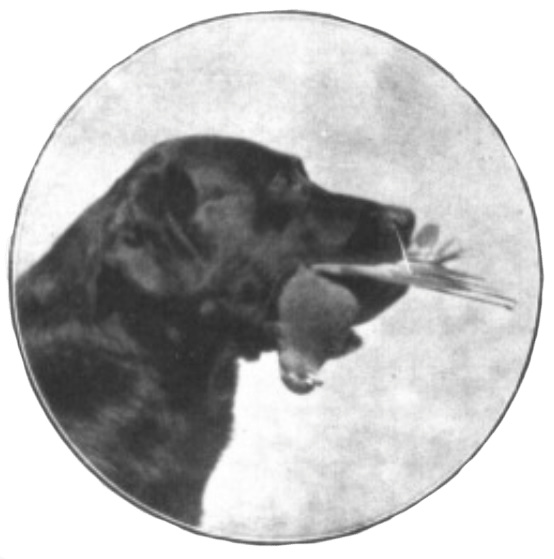
Banchory Bolo
Lorna and Bolo
She must have had a kind heart as she took him home with her. After taking off the muzzle and chain, she turned him loose in a spacious room, but he was distrustful and surly. He wouldn't come to anyone and it took quite a while to catch him.
Something must have happened to him in his earlier life. Heavy-handed trainer? Malicious kennel help?
He avoided people. When turned out for exercise, he was hard to catch. How could he be trained when he was so distrustful of people? What could soothe the savage beast?
It turns out it wasn't music, but Lorna's gentle care. When he became seriously ill, she nursed him back to health. During that time, he realized she was someone he could trust. As he recovered he became devoted to her and was always at her side.
The stirrings of greatness
When he started in training, Lorna found he had "a natural love of retrieving, an excellent nose, and a perfect mouth." However, he also had two failings: he loved chasing rabbits and was terrified of cracking whips. One day when a stable boy happened to crack a whip near him, the fear took over and Bolo blindly sought escape. A tall, spiked gate didn't stop him from running.
He returned early the next morning, covered in blood. "He had two very deep wounds on his chest, a tear three inches long in his groin and his hind leg and hock torn so badly that the bone was visible." Because a veterinarian was too far away, Lorna stitched his wounds as he lay still for her.
Her doctoring and subsequent training was well done as the next fall he won a field trial prize. Then he quickly won two field trials and became a field champion. Two years later he also finished his show championship and became the first Dual Champion Labrador.
Lorna said, "He had quite the best nose I have ever seen in a dog and with apparently the greatest ease he would collect runner after runner after several other dogs had failed. I have never had a dog with such great natural ability or one so anxious to please me in every possible way."
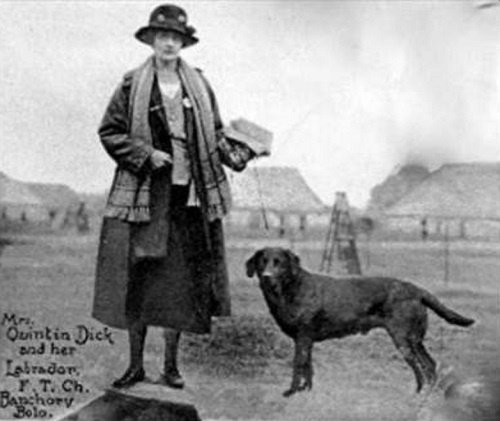
Lorna, Countess Howe and Banchory Bolo
From greatness comes greatness
The genes from several great dogs came together in Banchory Bolo. We have Lord Malmesbury, the Dukes of Buccleuch, and Lord Knutsford (Munden kennels) to thank for their breeding insight and the dogs they produced.
Banchory Bolo's pedigree:
| Scandal of Glynn | English FTCh Peter of Faskally | Waterdale Gamester |
| Birkhill Juliet | ||
| English FTW Shelagh of Glynn | English FTW Scamp of Glynn | |
| Shelagh of Danesbury | ||
| Caerhowell Nettle | Foxley Kennett | Hirsch's Ranger |
| Bendysh Bess | ||
| Baker's Nora | unknown | |
| unknown |
His family
Looking backward in time, Bolo's sire, Scandal of Glynn, was a son of English FTCh Peter of Faskally. Peter won the International Gundog League's Championship Stake for retrievers in 1911, but it was his partnership with his handler, Archie Butter, that set him apart from the other retrievers.
Butter realized that if a dog could be guided by his handler, the quicker he would be able to find and retrieve game. To do this, he adapted the methods used by shepherds when handling their dogs using whistles and hand signals. We still use a form of this method today.
Peter of Faskally's pedigree is filled with dogs from the Munden and Buccleuch kennels. Munden Sixty (born 1897) appears three times in Peter's pedigree and once more in Scandal of Glynn's maternal line.
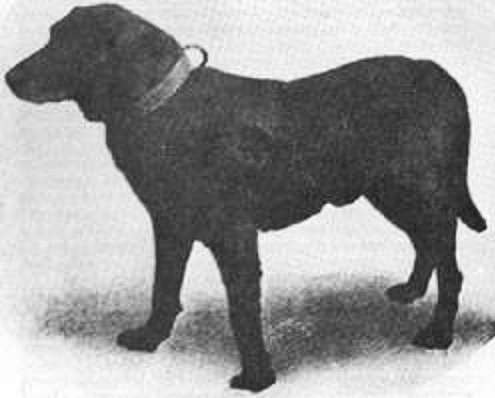
Buccleuch Avon
Sixty's paternal grandfather, Buccleuch Avon (born 1885), was a gift from the third Earl of Malmesbury to the sixth Duke of Buccleuch.
Avon was sired by Malmesbury Tramp (born 1878) and out of Malmesbury Juno (born 1878). Another male, Buccleuch Ned (born 1882), was also a gift. These dogs were bred to bitches that descended from dogs imported originally by the fifth Duke of Buccleuch.
Another great in Peter of Faskally's pedigree is Munden Single (born 1899). She was sired by Munden Sixty and descended from Munden, Buccleuch, and Malmesbury dogs. She's best known for being the first Labrador to win a Challenge Certificate and the first Labrador to run in a field trial.
More Munden, Buccleuch, and Malmesbury
Less is known about Scandal of Glynn's maternal side. His maternal grandfather, Scamp of Glynn FTW, traces to Buccleuch Ned, the other male gifted by Lord Malmesbury. And his maternal grandmother, Shelagh of Danesbury, is mostly from Munden dogs that trace back to the Buccleuch and Malmesbury kennels.
Even less is known about Banchory Bolo's mother, Caerhowell Nettle, although her father traces back to Peter of Faskally as well.
Bolo's legacy
With all the good genes passed down from his ancestors, it's not surprising that he also produced well. He sired both show champions and field trial champions.
Bolo's show offspring
In 1921, he was bred to Brocklehirst Nell (owned by Mrs. Dinwoodie) and sired English Ch Banchory Bluff, English FTCh Nith of Halleaths, and Brocklehirst Daisy FTW. Bluff was the maternal grandsire of English FTCh Balmuto Hewildo. Bluff was owned by Lorna.
Also in 1921, he was bred to Murrayfield Bett (owned by Mr. Dinwoodie) and sired English Ch Brocklehirst Donner. This dog was also owned by Lorna.
Yet another litter in 1921, produced English Ch Beningbrough Tangle. He finished his show championship, including winning the CC at Crufts in 1930 and he also won a field trial. So close to being another Dual Champion! He was bred by The Earl of Chesterfield and owned by Lorna. His mother was Thyme, a daughter of English Ch Ilderton Ben.
In 1922, Bolo was bred to a granddaughter of English Ch Ilderton Ben. Her name was Malta of Lunn and was owned by the Earl of Clarendon. In this litter was a female named English Ch Banchory Kelpie, owned by Lorna.
Breeding dogs all but stopped during World War I. This sent the Munden kennel to the edge of extinction. However Lorna "gave Lord Knutsford a puppy on the condition that he should eventually breed her with Dual Champion Banchory Bolo."
He registered this puppy as Munden Scarcity. Her sire was English Ch Banchory Lucky and her dam was Banchory Betty. In Scarcity's litter by Bolo, she produced both English Ch Banchory Danilo FTW and English Ch Munden Solo FTW. Lord Knutsford also kept Singer, a bitch, and another bitch was given to His Majesty the King.
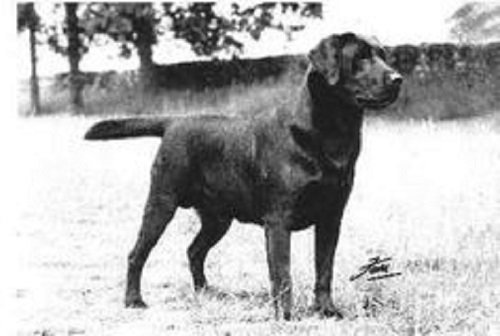
Banchory Danilo
One of Bolo's best sons
Danilo won 33 Challenge Certificates in the show ring and won the best exhibit in the Kennel Club Show in 1925. He went on to also win two field trial honors in 1924, handled by Lorna. Danilo sired English Ch Drinkstone Pons of Wingan (sire of American Ch Echo of Arden), English Ch Drinkstone Dan, and Haylers Danilo (sire of English Ch Poppleton Black Lancer).
When Danilo's grandson, Hiwood Risk, was bred to Peggy of Shipton we see some of the Arden dogs, including American National Field Champion Tar of Arden and her offspring - American FC Firelei of Deer Creek, American NFC Black Magic of Audlon, American Dual Ch CFC Little Pierre of Deer Creek.
Danilo's brother, Munden Solo, also did well at shows. At Crufts in 1927, he competed in ten classes, won six, and placed in three more. The judge wrote of him, ‘If there had been a little more of him in size, I think he would have been very near perfection.’
Bolo sired another English show champion, Banchory Bolo's Trust, in 1926. His mother was Beaulieu Nance (daughter of English DUAL Ch Banchory Sunspeck).
English DUAL Ch Bramshaw Bob, double-bred on Bolo, won Best in Show at Crufts twice - 1932 and 1933. Lorna bought him from Sir George Thursby and when she took him to Crufts in 1932, Bob won all the classes he was entered in and won Best in Show on the second day.
Lorna said, "Cruft's Show was, and still is, a great meeting place for gamekeepers. I shall never forget the overwhelming reception they gave Bob when the award was announced; it was so kind of them. They were pleased that a working gundog should receive this much-coveted award."
Bolo's field offspring
Bolo was bred to Kirkmahoe Dinah FTW in 1921. This litter included English National FTCh Kirkmahoe Rover, Banchory Corbie FTW, and Choice Of Kirkmahoe FTW.
Banchory Corbie won one Challenge Certificate (show points) and won the 1923 International Gundog League (IGL) Nomination Stake. Then he "broke his shoulder by galloping into a guard post" thus ending his show and field trial career. Lorna described him, "Corbie was in character and temperament all that a Labrador should be. He was highly intelligent, very faithful, a wonderful watch-dog and guard, yet very gentle with children. He had the great game-finding ability which goes with good nose and the brains to use it."
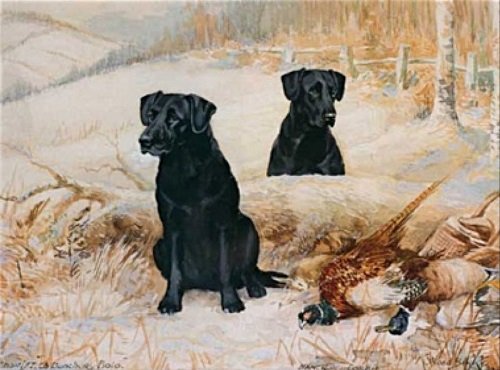
Banchory Bolo and his son, Banchory Corbie
Another Bolo son was born in 1923, Banchory Roger FTW. He was linebred on English National Ch Peter of Faskally and on Munden Sentry.
Another male, English FTCh Balmuto Hewildo, was also double-bred on Bolo. Instead of winning in the show ring, he won the IGL Retriever Championship in 1936. This is comparable to the National Retriever Championship in the US.
In short, Bolo was a great producer.
A legend
Author C. Mackay Sanderson wrote, "Bolo's coming may be said to have breathed a spirit of new life into the breed, the prestige enjoyed by this dog as a competitive and stud force giving lasting impetus to Labrador fortunes and subsequently his name runs like a golden thread through all the vital streams of progress."
"The Field wrote of Bolo: 'If ever evidence were needed of the character of a great dog, and of his influence on the generations following him, it was to be found at the Retriever Championship Trial held at Idsworth last week [December 1932]. Out of fourteen dogs that won prizes, eight were descended from Banchory Bolo.'"
But Bolo also had another legacy - he tended to throw white hairs on the feet. These 'Bolo marks' or 'Bolo pads' are still sometimes seen on the bottom of the front feet and/or the back of the front pasterns.
Bolo died in July 1927. It was ten years before Lorna was able to give her heart to another dog.
English Dual Champion Banchory Bolo
Whelped: December 29, 1915
Died: July 10, 1927
Owner: Lorna, Countess Howe (AKA Mrs. Quintin Dick)
Breeder: Sir John S Harmood-Banner
Original name: Caerhowell Bully
Registration: KC SB 218AA
1. Although she became Lorna, Countess Howe because of her second marriage, she was known as Mrs Quintin Dick during Bolo's lifetime. However for the sake of ease, I've used her first name here as it's how she's known by Lab enthusiasts worldwide.
Abbreviations:
Ch - Show champion
CC - Challenge Certificate (show points)
FCh - Field trial champion
NFCh - National field trial champion
FTW - Field trial winner (not a title)
CFC - Canadian field champion
IGL - International Gundog League


